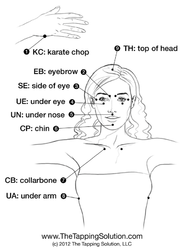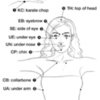 I’ve used Emotional Freedom Technique (EFT) aka tapping for years, as I wrote in Part 1, which described “what is tapping."
I’ve used Emotional Freedom Technique (EFT) aka tapping for years, as I wrote in Part 1, which described “what is tapping."
Now for how to tap. “The basic technique requires you to focus on the negative emotion at hand: a fear or anxiety, a bad memory, an unresolved problem, or anything that’s bothering you,” says Nick Ortner, author of “The Tapping Solution.”
Then, “while maintaining your mental focus on this issue, use your fingertips to tap 5-7 times each on 9 of the body’s (dozens of) meridian points” (Click on “Where to Tap” diagram above from TheTappingSolution.com to see full graphic.)
“Tapping on these meridian points, while concentrating on fully feeling and accepting the negative emotion, will allow you to resolve and displace those learned, habitual reactions this feeling would ordinarily trigger,” he writes.
You said it, brother Nick. “Fully feeling and accepting the negative emotion” is an incredibly key point; see below.
But please: if you have severe trauma, do not tap alone! Do it with a therapist or trained practitioner, or don’t tap. Others please note: I’m making “I Statements” here, not giving advice. “Your mileage may vary.”
Tapping starts with 3 “prep steps” which should take about 5-10 minutes once we get used to it. Here we take the time to become fully Present with ourselves, our body, and our emotions. Actual feelings, and relief of feelings, occurs only “in the Now.” To do it, we’ve got to be Present in the Now.
1. Identify what’s troubling you. It can a specific feeling or situation, or just general anxiety or “I feel lousy.” Try to figure out “what bugs me the most and how do I feel about it now?” Try to put yesterday and tomorrow out of your mind. Just ask this “now” question until you feel some sort of answer.
2. Write down the intensity of your feeling on a scale of 0 (doesn’t bug me) to 10 (could jump out of my skin over it). This “Subjective Units of Discomfort Scale” (SUDS) is useful because often we feel so much better after tapping that we simply can not remember how bad it felt beforehand.
3. Create a one-sentence “set-up statement” which says: I’m going to accept myself and practice self-compassion. I’m deciding to fully accept me as I am, the emotions troubling me, even my worst feelings. Because, as Dr. Tara Brach says, “it’s only when we accept ourselves completely exactly how we are, that we become free to change.”
Anxiety, Anyone?
Let’s take as a sample, the feeling of simple general anxiety – we’ve all had it, it’s easy to feel, and when it gets bad, it can cause panic and illness. Resolving anxiety is always good.
So 1: Are you feeling at all anxious? 2. Write down the intensity on a scale of 0 to 10.
3. Here are “set-up statements” about general anxiety I’ve found most useful from Nick Ortner’s e-book 2012 edition: “Your set up statement should acknowledge the problem you want to deal with, then follow it with an unconditional affirmation of yourself as a person,” he writes:
–“Even though I feel this general anxiety, I deeply and completely accept myself.”
–“Even though I’m anxious about [__ situation], I deeply and completely accept myself.”
–“Even though I’m feeling this anxiety about [__ person] I deeply and completely accept myself.”
–“Even though I panic when I think about [ __ ] I deeply and completely accept myself. ”
We only need one set-up sentence. Create one or pick one; the above are just samples.
At the end of my “set-up” statement I often add “and all my traumatized emotions.” I’ll say, “Even though I feel anxious and panicky, I deeply and completely accept myself, and all my traumatized emotions.” (My therapist applauded this addition. If we accept that our "crazy" trauma is not crazy, thank you, but actually it's to be fully expected, given the nasty experiences we’ve had? Doing that really helps heal it.)
READ MORE: http://attachmentdisorderhealing.com/tapping-2/



Comments (5)